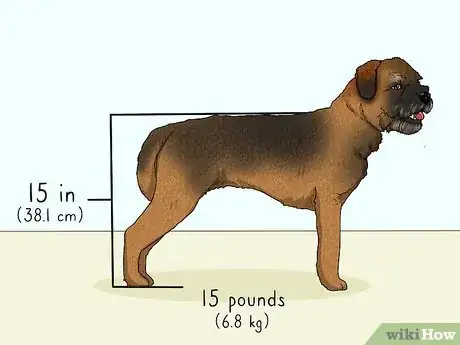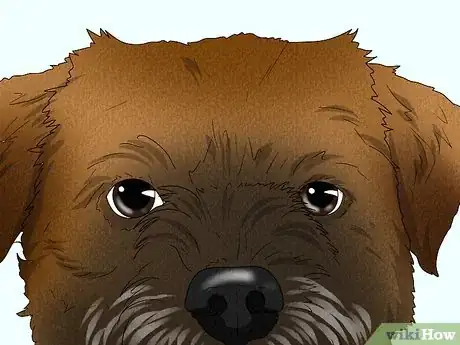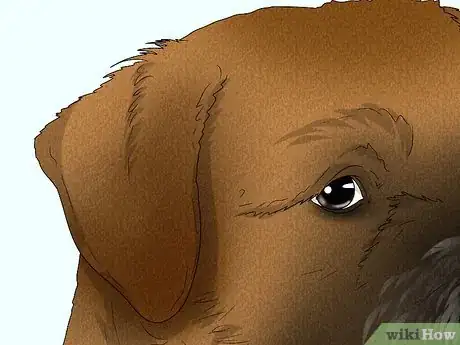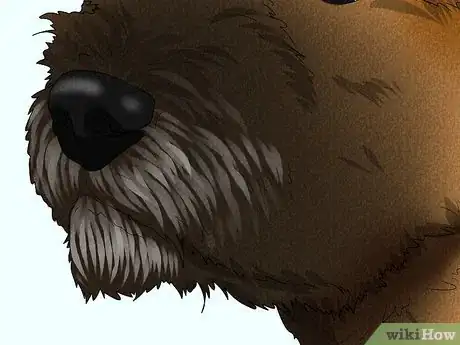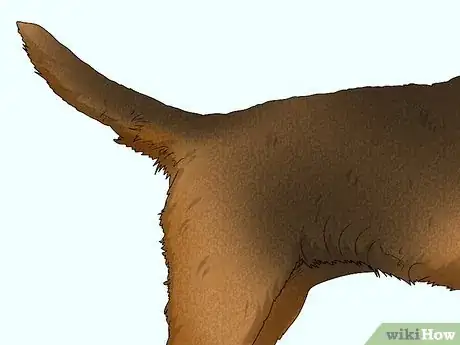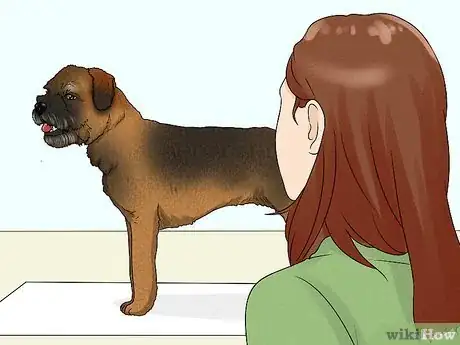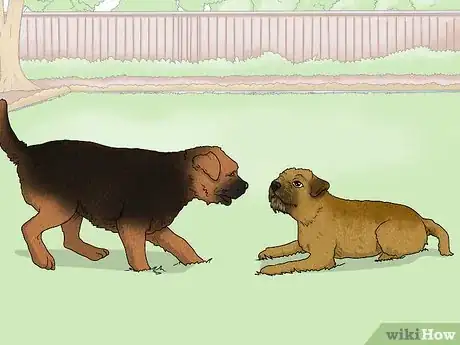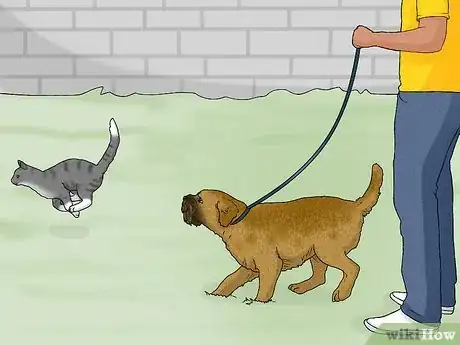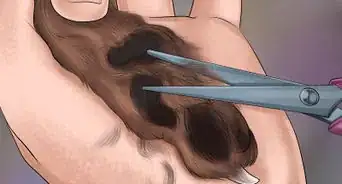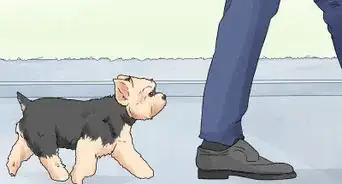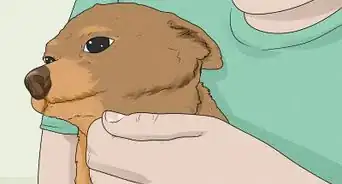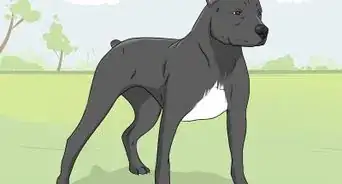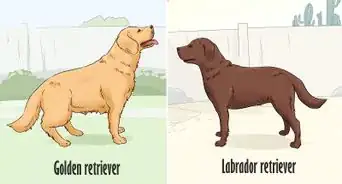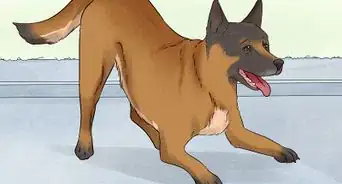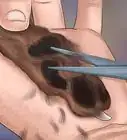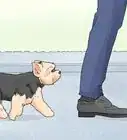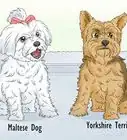wikiHow is a “wiki,” similar to Wikipedia, which means that many of our articles are co-written by multiple authors. To create this article, volunteer authors worked to edit and improve it over time.
This article has been viewed 7,802 times.
Learn more...
Border Terriers are small-sized dogs and are a member of the terrier group.[1] Borders have been described as 'hard as a nail' when working, but at home they're affectionate, good-tempered and trainable.[2] Border Terriers share some traits with other dogs, but by recognising their key traits, Borders can be more easily identified. This wikiHow will help you know whether or not a dog is a Border Terrier.
Steps
Taking Notice of Body Structure
-
1Check the dog's size. Border Terriers are fairly small dogs. They are only 12–15 inches (30.5–38.1 cm) tall and males weigh 13–15 pounds (5.9–6.8 kg) whilst females weigh 11.5–14 pounds (5.2–6.4 kg).[3]
-
2Look at the eyes. Borders have dark hazel coloured eyes which are full of fire and intelligence. The eyes are medium sized and not too prominent or beady.[4]Advertisement
-
3Notice the ears. A Border Terrier has small V-shaped ears which are medium in size and generally darker coloured. The ears aren't set high on the head, but more to the sides of the head.[5]
-
4Inspect the muzzle. Borders usually have rather short muzzles that are darker coloured. A few short whiskers are natural. They have a good-sized, black nose, and a bite which is large in proportion to the dog.[6]
-
5View the tail. Border Terriers have moderately short tails which are thick at the base. The tail isn't set too high, but it is carried brightly when the dog is alert.[7]
-
6Examine the overall structure. Border Terriers have a deep, fairly narrow body which has enough length to be agile. The shoulder blades are well laid back, meeting the withers gradually. The dog has muscular and racy hind legs with long thighs, and the feet in front.[8]
Recognising the Coat
-
1
-
2Notice the colour of the coat. Borders have a range of colours that they can be, however there are 4 different colors that are standard and approved as purebred. Any of these colours that the dog can be may have a small amount of white markings on the chest.[11]
- The acceptable purebred coat colours for Border Terriers are red, grizzle and tan, blue and tan and wheaten.[12]
- Other more unusual (and not recognized as purebred) coat colours include black and red, black and tan, black grizzle, blue grizzle, grizzle, red grizzle, red grizzle and tan, and red wheaten.[13]
Identifying Temperament
-
1
-
2Look for independence. Borders are independent in many ways, and may also be stubborn.[17] The dog will want to escape any back yards or places they're in, to explore the outside world. This curiosity is something that helps them learn new tricks.
-
3Watch for how social the dog is. Most Border Terriers are social dogs with both humans and other dogs. They'll usually want to greet strangers with bounciness, and will get along alright with other dogs.[18]
-
4Check the dog's reaction to other animals. Borders get along with animals they've been raised with, but any animals they might consider prey (including smaller dog breeds, like those in the toy group[19] ) are out of the question.[20] They'll feel compelled to run and harass anything that moves quickly.[21] Border Terriers also have a hunting background, and this will often come into play if a cat crosses their path.[22]
Did you know? Borders on the farm in the 18th century were expected to find their own food, so they had to be good hunters to survive.[23]
References
- ↑ https://www.akc.org/dog-breeds/border-terrier/
- ↑ https://www.akc.org/dog-breeds/border-terrier/
- ↑ https://www.akc.org/dog-breeds/border-terrier/
- ↑ https://images.akc.org/pdf/breeds/standards/BorderTerrier.pdf
- ↑ https://images.akc.org/pdf/breeds/standards/BorderTerrier.pdf
- ↑ https://images.akc.org/pdf/breeds/standards/BorderTerrier.pdf
- ↑ https://images.akc.org/pdf/breeds/standards/BorderTerrier.pdf
- ↑ https://images.akc.org/pdf/breeds/standards/BorderTerrier.pdf
- ↑ https://images.akc.org/pdf/breeds/standards/BorderTerrier.pdf
- ↑ https://www.akc.org/dog-breeds/border-terrier/
- ↑ https://images.akc.org/pdf/breeds/standards/BorderTerrier.pdf
- ↑ https://www.akc.org/dog-breeds/border-terrier/
- ↑ https://www.akc.org/dog-breeds/border-terrier/
- ↑ https://www.dogtemperament.com/border-terrier-temperament/
- ↑ https://www.yourpurebredpuppy.com/reviews/borderterriers.html
- ↑ https://www.yourpurebredpuppy.com/reviews/borderterriers.html
- ↑ https://www.dogtemperament.com/border-terrier-temperament/
- ↑ https://www.yourpurebredpuppy.com/reviews/borderterriers.html
- ↑ https://www.akc.org/expert-advice/lifestyle/meet-border-terrier/
- ↑ https://www.dogtemperament.com/border-terrier-temperament/
- ↑ https://www.dogtemperament.com/border-terrier-temperament/
- ↑ https://www.akc.org/dog-breeds/border-terrier/
- ↑ https://www.akc.org/dog-breeds/border-terrier/
